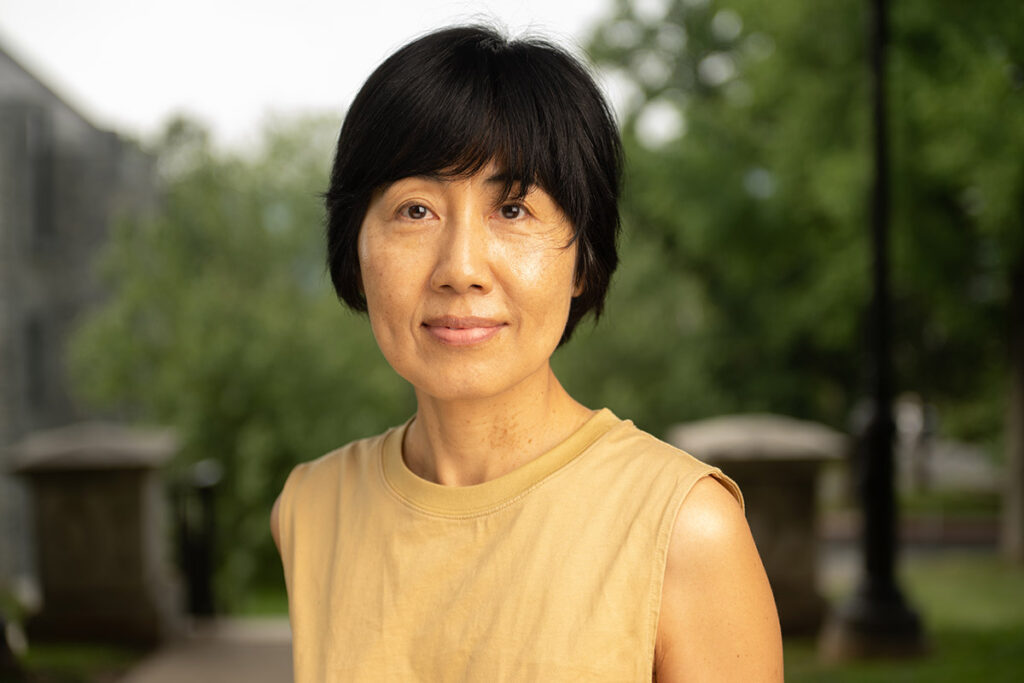Highlighting our faculty
- Faculty at Lafayette College are renowned leaders in their respective fields, exceptional teachers and dedicated mentors. Read more about our faculty.
Learn more about Sun You, assistant professor of art

What I study and why: In my life, I have moved and traveled a lot. This fluidity and impermanence have influenced how I think and make. I prioritize flexibility and lightness. My work does not require fixed sites of production, is easily packed, and made spontaneously. In my multimedia painting and sculpture, I use a mix of everyday objects and craft materials to create provisional tableaus that celebrate women’s work, domestic ornamentation, and the language of abstraction.
For a recent solo exhibition, This Two, I made a series of tabletop sculptures that loosely reference Ikebana, the Japanese art of flower arrangement. Ikebana flower arrangements have their own internal logic of line, color, and shape that is both immediately pleasing and also suggestive of a larger world or universal order. The sculptures I make are constructed with wire, eyelash extensions, beads, sewing needles, paper clips, razor blades, and artificial plants. They are held together by gravity and magnets in transitional groupings that vary with each installation, evoking the impermanence and interdependence I see around me.
My abstract panels are both paintings and wall reliefs. The works are made with polymer clay, acrylic paint, and wood. Polymer clay, one of my primary materials, is typically used in crafts like bead making. The association with domesticity and baking in my work is reinforced through hand building techniques of rolling, pinching, and firing clay in my home oven. The largest of these works, No Title, is composed of multiple panels. Each time it is shown, I add more panels, extending or rearranging them depending on where it is hung. I like the idea that this large work can change and playfully evolve in space and time.
My work is intuitive. I often group forms by shape and color. I also introduce a chance to interrupt my own tastes and habits. Recently I’ve been exploring compositions derived from how I pack artwork for travel. After baking clay pieces, I put them in cardboard boxes to move to the studio. The arrangement of the polymer clay is based on function—I organize them so they won’t break. These functional groupings have formed the basis for new wall works and floor sculptures.
Growing up in South Korea, we had a floor-centered culture—meaning we would eat, study, and sleep on the floor. This has also influenced my working process, which in turn affects how my art looks. I make most of my works on the floor, arranging compositions without considering orientations like up or down, left or right. This openness to spatial orientation reflects my experiences of writing and translating between Hangul and English, which can be written vertically and horizontally, respectively. This linguistic connection also influences the forms I use in many works. I sometimes make Hangul alphabetic characters arranged in configurations that are linguistically meaningless but suggest textual possibilities.
This fall I’m teaching: I will teach two painting 1 classes this coming fall.
What students can expect from me: My classes prioritize interdisciplinary exploration, research, and collaboration. For instance, my painting projects are grounded in a variety of materials and techniques. These include the use of traditional media—oil and acrylic—as well as nontraditional approaches using found objects, digital drawing tablets, large format printing, and laser cutting. Students play an active role in choosing their own subject matter based on our shared conversations as well as their interests and research. This research is a core part of my curriculum. I introduce contemporary artists and practices in my lectures, take classes to see art on campus, and bring them on field trips to museums, galleries, and artist studios. Students also give presentations about artists relevant to our class projects. Collaborative group exercises are another important part of my classes. Examples of this include having students combine their individual painting into larger installations or curate and promote exhibitions of their peers on campus.
I’m excited to be here because: I have thoroughly enjoyed my time at Lafayette as a visiting professor. I found the students to be conceptually ambitious and hardworking. My fellow faculty and department leadership have been welcoming and supportive of my teaching and research. The expansive facilities and classroom budget have proven vital for the implementation of my projects and success of my students. I am excited to be here for the long term, making a significant contribution to Lafayette as a visible artist, a classroom teacher, a mentor, and a community member.
Getting to know me: I served as assistant professor of art for the 2022-23 academic year here at Lafayette and come from Wayne State University and BFA, studio art, College for Creative Studies. A New York-based artist, I’ve exhibited my work in galleries and museums internationally. I also founded and manage President Clinton Projects, a curatorial project, and co-run a nonprofit artist collective gallery, Tiger Strikes Asteroid, in New York.
Continue reading to meet more of Lafayette’s newest faculty members.